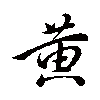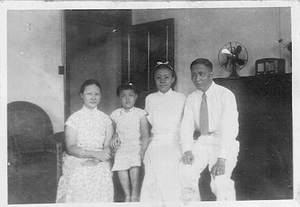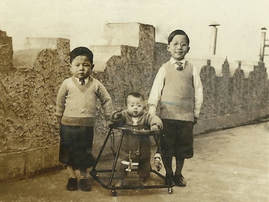Children at Last
From 1934
When Zing Wei pledged herself to Han Liang, we assume there was little question that she would promptly give up her nursing career. Was she relieved or conflicted to no longer have to support herself? As respectable as the field of nursing may have been in anything-goes Shanghai, there must still have been greater respectability in the traditional path of wife and mother.
On May 21, 1934, eleven months after Yu Koon's death, Zing Wei and Han Liang welcomed a first daughter, apparently called "May" after the month. Then and now, wagging tongues wondered whether May was truly Han Liang's. Frankly, if she was not, accepting her as his own at least offered a fast way out of his childless fate of the previous decade. In Chinese, May was named Sze Chin (思勤 Siqin). Later she would be known as “Roni”, short for “Veronica”. It was the Year of the Dog by the Chinese zodiac.
Any lingering doubts about May's legitimacy should have been rendered moot when Peter or “Chung Ren” (宗仁 Zongren) was born on July 25, 1935, in the Year of the Pig, followed by Paul or “Chung Yi” (宗義 Zongyi) on November 30 , 1936, in the Year of the Rat.
Han Ho’s wife Peggy is believed to have delivered their third child, Lulu, in 1933 at the Woman’s Hospital at 105 Great Western Road (now 延安路 Yan’an Lu), called simply “Great Western Hospital” (大西醫院 Daxi Yiyuan). After the difficulties Peggy had had in giving birth to Mary and getting pregnant again, it's understandable that they would have chosen a hospital.
As for Zing Wei, one might think that as a former nurse she would have also chosen a hospital, and perhaps the one where she studied and worked for so many years, but in fact nothing is known about the birthplace of her children. Nonetheless, it certainly seems that her connection to the Episcopal diocese associated with St. Elizabeth's Hospital was influential in her and Han Liang's choice of English names for the boys: the diocese's main church was St. Peter's, and other churches had included a St. Paul's and a St. Stephen's. All that said, it should be noted that they never chose to name a daughter Elizabeth.
A small mystery lies in the fact that Han Liang and Zing Wei broke with family custom for the Chinese names of their children. Younger brother Han Ho and younger first cousin Han Yang had had their first children in the 1920s, and both used the shared generational name of “Ling”(齡) as the second character of their children's names, as would cousin Han Chung in due course. But Han Liang and Zing Wei struck out in a different direction.
Often such generational names are set out far into the future in a family genealogy, but for the Huangs, this is not believed to have been the case. “Ling” would appear to be a name that Han Ho simply came up with, by whatever means or for whatever reason. It was an era when many old customs were falling by the wayside and others were in flux. The giving of English names, for example, was adopted by both Han Liang and Han Ho, but not by their cousins.
Yet in going their own way, Han Liang and Zing Wei still selected Chinese names that were highly respectful of tradition – almost iconically orthodox. The “Sze” in May’s name and, later, Helen’s (思梅 Sze-mei/Simei), presumably refers to Xiamen’s old name of “Sze-ming”, while Chin means “diligence” and Mei “plum”. The “Mei” is said to have come from Zing Wei's mother’s name, Sun Jingmei (孫景梅).
The boys’ shared character “Chung” (宗 Zong) signifies an ancestral lineage or school of thought – i.e., something defining that is worthy of being handed down. Each of their respective second characters came from one of the five Confucian virtues: “Ren, Yi, Li, Zhi, Xin” (仁義禮智信) – “benevolence”, “duty”, “propriety”, “wisdom” and “trust”. (There would be a total of four Huang boys, with Chung Li 宗禮 and Chung Chih 宗智 to follow.)
Might there have been a political statement in the Huangs reasserting the classic Confucian virtues at the exact time when Chiang Kai-shek and Soong May-ling were promulgating their own variant of the virtues? In 1934, Chiang and his wife had launched the New Life Movement (新生活運動 Xin Shenghuo Yundong), a campaign to promote hygiene as well as general social uplift. “Li, Yi, Lian, Chi” (禮義廉恥) – “propriety”, “duty”, “honesty” and “morality” – were chosen as the watchwords of the Movement. Many educated Chinese sniffed at this heavy-handed drive to improve society. Were Han Liang and Zing Wei falling in line with this campaign or one-upping it?
Perhaps the latter if one notes that in bypassing "Ling" for their children, they were rejecting the shared character that made up the names of Soong May-ling and her sisters, so famously married to Chiang Kai-shek, Sun Yat-sen, and finance minister HH Kung.
Whatever their exact thinking, Han Liang and Zing Wei clearly made the choice to stand apart from the precedent set by the younger members of the Huang family.
On May 21, 1934, eleven months after Yu Koon's death, Zing Wei and Han Liang welcomed a first daughter, apparently called "May" after the month. Then and now, wagging tongues wondered whether May was truly Han Liang's. Frankly, if she was not, accepting her as his own at least offered a fast way out of his childless fate of the previous decade. In Chinese, May was named Sze Chin (思勤 Siqin). Later she would be known as “Roni”, short for “Veronica”. It was the Year of the Dog by the Chinese zodiac.
Any lingering doubts about May's legitimacy should have been rendered moot when Peter or “Chung Ren” (宗仁 Zongren) was born on July 25, 1935, in the Year of the Pig, followed by Paul or “Chung Yi” (宗義 Zongyi) on November 30 , 1936, in the Year of the Rat.
Han Ho’s wife Peggy is believed to have delivered their third child, Lulu, in 1933 at the Woman’s Hospital at 105 Great Western Road (now 延安路 Yan’an Lu), called simply “Great Western Hospital” (大西醫院 Daxi Yiyuan). After the difficulties Peggy had had in giving birth to Mary and getting pregnant again, it's understandable that they would have chosen a hospital.
As for Zing Wei, one might think that as a former nurse she would have also chosen a hospital, and perhaps the one where she studied and worked for so many years, but in fact nothing is known about the birthplace of her children. Nonetheless, it certainly seems that her connection to the Episcopal diocese associated with St. Elizabeth's Hospital was influential in her and Han Liang's choice of English names for the boys: the diocese's main church was St. Peter's, and other churches had included a St. Paul's and a St. Stephen's. All that said, it should be noted that they never chose to name a daughter Elizabeth.
A small mystery lies in the fact that Han Liang and Zing Wei broke with family custom for the Chinese names of their children. Younger brother Han Ho and younger first cousin Han Yang had had their first children in the 1920s, and both used the shared generational name of “Ling”(齡) as the second character of their children's names, as would cousin Han Chung in due course. But Han Liang and Zing Wei struck out in a different direction.
Often such generational names are set out far into the future in a family genealogy, but for the Huangs, this is not believed to have been the case. “Ling” would appear to be a name that Han Ho simply came up with, by whatever means or for whatever reason. It was an era when many old customs were falling by the wayside and others were in flux. The giving of English names, for example, was adopted by both Han Liang and Han Ho, but not by their cousins.
Yet in going their own way, Han Liang and Zing Wei still selected Chinese names that were highly respectful of tradition – almost iconically orthodox. The “Sze” in May’s name and, later, Helen’s (思梅 Sze-mei/Simei), presumably refers to Xiamen’s old name of “Sze-ming”, while Chin means “diligence” and Mei “plum”. The “Mei” is said to have come from Zing Wei's mother’s name, Sun Jingmei (孫景梅).
The boys’ shared character “Chung” (宗 Zong) signifies an ancestral lineage or school of thought – i.e., something defining that is worthy of being handed down. Each of their respective second characters came from one of the five Confucian virtues: “Ren, Yi, Li, Zhi, Xin” (仁義禮智信) – “benevolence”, “duty”, “propriety”, “wisdom” and “trust”. (There would be a total of four Huang boys, with Chung Li 宗禮 and Chung Chih 宗智 to follow.)
Might there have been a political statement in the Huangs reasserting the classic Confucian virtues at the exact time when Chiang Kai-shek and Soong May-ling were promulgating their own variant of the virtues? In 1934, Chiang and his wife had launched the New Life Movement (新生活運動 Xin Shenghuo Yundong), a campaign to promote hygiene as well as general social uplift. “Li, Yi, Lian, Chi” (禮義廉恥) – “propriety”, “duty”, “honesty” and “morality” – were chosen as the watchwords of the Movement. Many educated Chinese sniffed at this heavy-handed drive to improve society. Were Han Liang and Zing Wei falling in line with this campaign or one-upping it?
Perhaps the latter if one notes that in bypassing "Ling" for their children, they were rejecting the shared character that made up the names of Soong May-ling and her sisters, so famously married to Chiang Kai-shek, Sun Yat-sen, and finance minister HH Kung.
Whatever their exact thinking, Han Liang and Zing Wei clearly made the choice to stand apart from the precedent set by the younger members of the Huang family.
THE "LINGS" BORN UP TO THIS TIME


